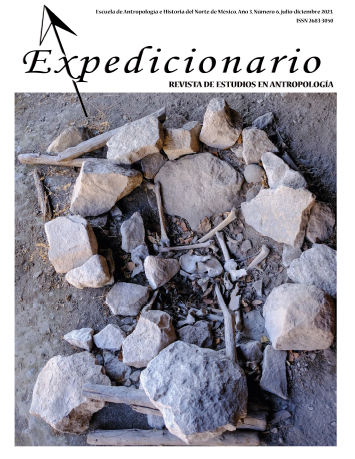Robustez como indicador de cuerpo político.: Aproximación a patrones de actividad en los Andes Orientales colombianos
Publicado 2024-01-08
Palabras clave
- Nueva Esperanza,
- Muyscas,
- Condiciones de vida,
- Trabajo,
- Indicadores de disrupción biológica
Derechos de autor 2023 Instituto Nacional de Antropología e Historia

Esta obra está bajo una licencia internacional Creative Commons Atribución-NoComercial 4.0.
Resumen
Este trabajo evaluó la robusticidad del húmero y del fémur, considerado como uno de los indicadores óseos que aproxima a patrones de actividad y que permite inferir aspectos del cuerpo político de las personas. Se evaluaron 34 individuos adultos de una serie esquelética perteneciente a los antiguos habitantes de una comunidad muysca asentada en los Andes Orientales colombianos, y de la cual solo se tuvo en cuenta el periodo Muisca Temprano (1750 AP-900 AP). Los datos revelaron que una proporción considerable de personas desarrollaron morfologías óseas que prevalecieron por encima de los valores del promedio en ambos huesos. Se asume un compromiso social hacia el trabajo mecánico arduo, asociado con su modo y estrategia de subsistencia.
Descargas
Referencias
- Agarwal, S. (2016). Bone Morphologies and Histories: Life Course Approaches in Bioarchaeology. Yearbook of Physical Anthropology, 159, 130–149.
- Argüello-García, P. M. (2016). Arqueología regional en el valle de Tena: un estudio sobre la microverticalidad muisca. Antipoda, 25(1), 143–166.
- Armelagos, G. (1998). Introduction: sex, gender and health status in prehistoric and contemporary populations. En A. L. Grauer y P. Stuart-Macadam (Eds.), Sex and gender in paleopathological perspective (pp. 1–9). Cambridge: Cambridge University Press.
- Bass, W. (1995). Human Osteology. A Laboratotory and Field Manual. Missouri: Archaeological Society.
- Blanton, R. (1995). The cultural foundations of inequality in households. En T. Price y G.Feinman (Eds.), Foundations of Social Inequality (pp. 105–127). New York: Plenum Press.
- Boada-Rivas, A. M. (2018). Control sobre tierras, sistemas de camellones, canales y mano de obra durante el periodo prehispánico en la sabana de Bogotá, Colombia. Latin American Antiquity, 29(4), 660–680.
- Bruzek, J. (2002). A method for visual determination of sex, using the human hip bone. American Journal of Physical Anthropology, 117(2), 157–168.
- Calderón-Patiño, D., Huertas, J, Marulanda-Guaneme, C. et al., (2019). Bioantropología y contextos funerarios. En T. Santa, J.
- C. Vargas, y P. Argüello (Eds.), Arqueología de Nueva Esperanza (pp. 83–100). Tunja: Codensa S.A.ESP en convenio con la Universidad Pedagógica y Tecnológica de Tunja UPTC.
- Csordas, T. J. (1990). Embodiment as a Paradigm for Anthropology. Ethos, 18(1), 5–47.
- Gamboa-Mendoza, J. (2016). Los grupos muyscas en el momento de la conquista española y su incorporación a la monarquía castellana siglos XVI y XVII. En M. E. Montes-Rodríguez y C.
- Moya-Pardo (Eds.), Muysca: memoria y presencia (pp. 21–54). Bogotá: Universidad Nacional de Colombia.
- Harrod, R. (2018). The Bioarchaeology of Social Control. Assessing Conflict and Cooperation in Pre-Contact Puebloan Society. En Bioarchaeology and Social Theory. Nueva York: Springer.
- Hendon, J. (2004). Living and Working at Home: The Social Archaeology of Household Production and Social Relations. En L. Meskell (Ed.), Companion to social archaeology (pp. 272–286).
- Oxford: Blackwell Publishing.
- Huertas, J., Moreno, O., Santa T. (2019). Caracterización del área de estudio y antecedentes arqueológicos. En T. Santa, J. C. Vargas, y P. Argüello (Eds.), Arqueología de Nueva Esperanza (pp. 83–100). Tunja: Codensa S.A.ESP en convenio con la Universidad Pedagógica y Tecnológica de Tunja UPTC.
- Klales, A. R., Ousley, S. D., y Vollner, J. M. (2012). A revised method of sexing the human innominate using Phenice’s nonmetric traits and statistical methods. American Journal of Physical Anthropology.
- Langebaek, C. (1985). Cuando los muiscas diversificaron la agricultura y crearon el intercambio. Boletín Cultural y Bibliográfico, 22 (03), 3–10.
- Langebaek, C. (1987). Mercados, poblamiento e integración étnica entre los muiscas siglo XVI. Bogotá: Colección Bibliográfica Banco de la República.
- Langebaek, C. (2019). Los muiscas: la historia milenaria de un pueblo chibcha. Bogotá: Penguin Ramdom House.
- Larsen, C. (1997). Bioarchaeology: Interpreting Behavior from the Human Skeleton. Cambridge: Cambridge University Press.
- Larsen, C. (2015). Bioarchaeology: Interpreting behavior from the human skeleton. Cambridge: Cambridge University Press.
- Larsen, C., Crosby, A., Griffin, C. et al. (2002). A Biohistory of Health and Behavior in the Georgia Bight The Agricultural Transition and the Impact of European Contact. En R. Steckel y J. Rose
- (Eds.), The backbone of history. Health and nutrition in the western hemisphere.Reconstructing health profiles: from skeletal remains (pp. 406–440). Cambridge: Cambridge University Press.
- Leatherman, T., y Goodman, A. (2020). Building on the biocultural syntheses: 20 years and still expanding. American Journal of Human Biology, 32(4), 1–14.
- Martin, D., Harrod, R., y Pérez, V. (2013). Bioarchaeology. An Itegrated Approach to Working with Human Remains. Nueva York: Springer.
- Marulanda-Guaneme, C. (2020). Salud y nutrición en un segmento de la población prehispánica de Nueva Esperanza durante el Muisca Temprano (200-1000 d.C). Tesis de Maestría en Antropología Física. Escuela Nacional de Antropología e Historia. Ciudad de México.
- Miller, J., Agarwal, S., Aristizabal, L., y Langebaek, C. (2018). The daily grind: Sex- and age-related activity patterns inferred from cross-sectional geometry of long bones in a pre-Columbian
- muisca population from Tibanica, Colombia. American Journal of Physical Anthropology, 167(2), 311–326.
- Quiroga, M. (2008). Las unidades sociopolíticas muiscas en el siglo XVI. En J. Gamboa (Ed.), Los muiscas en los siglos XVI y XVII: miradas desde la arqueología, la antropología y la historia (pp. 94–115). Tunja: Universidad Pedagógica y Tecnológica de Tunja UPTC.
- Rivas, S., Calderón, D., Marulanda, C. et al., (2023). Stable isotopes and paleodiet of the ancient inhabitants of Nueva Esperanza: A late Holocene site from Sabana de Bogotá (Colombia). International Journal of Osteoarchaeology, Septiembre de 2022, 1–14.
- Rodríguez-Cuenca, J. V. (2011). Los chibchas: hijos del sol, la luna y los Andes. Origen de su diversidad. Bogotá: IDU-Alcaldía Mayor de Bogotá, D.C.
- Rojas-Sepúlveda, C., Ardagna, Y., y Dutour, O. (2008). Paleoepidemiology of vertebral degenerative disease in a Pre-Columbian Muisca series from Colombia. American Journal of Physical Anthropology, 135(4), 416–430.
- Romano-Gómez, F. (2018). Nueva Esperanza. 2000 años de Historia Prehispánica de una Comunidad en el Altiplano Cundiboyacense. (Editado por P. Argüello). Tunja: EPM, CODENSA S.A. ESP., UPTC.
- Ruff, C. (2008). Biomechanical Analyses of Archaeological Human Skeletons. En A. Katzenberg y S. Saunders (Eds.), Biological Anthropology of the Human Skeleton (pp. 183–206). Nueva Jersey: Willey-Liss.
- Ruff, C. (2018). Quantifying Skeletal Robusticity. En C. Ruff (Ed.), Skeletal Variation and Adaptation in Europeans: Upper Paleolithic to the Twentieth Century (pp. 39–47). Wiley Blackwell.
- Ruiz, J. (2016). Agricultura y movilidad en la población muisca del sitio arqueológico Nueva Esperanza. Análisis de marcadores óseos de estrés ocupacional. En INGETEC (Ed.), Informe final. Propuesta de implementación de plan de manejo arqueológico: Subestación Nueva Esperanza, Soacha, Cundinamarca. Tomo III (pp. 112–130). Bogotá: EPM-INGETEC S.A.
- Sánchez Hastamorir, M., Argüello García, P., y Rojas-Sepúlveda, C. (2023). Diferenciación social y condiciones de vida en el Cercado Grande de los Santuarios (2350-450 AP), un centro político y ritual en el Altiplano Cundiboyacense, Colombia. Latin American Antiquity, 34(2), 404–422.
- Santa-Ríos, T., Vargas, J.C., y Arguello, P. (2019). Arqueología de Nueva Esperanza. Tunja: CODENSA S.A ESP y Universidad Pedagógica y Tecnológica de Colombia-UPTC.
- Schepartz, L. A. (2017). The body of power, the body of memory. Reviews in Anthropology, 46(1), 35–53.
- Scheper-Hughes, N. y Lock, M. (1987). The Mindful Body: A Prolegomenon to Future Work in Medical Anthropology. Medical Anthropology Quarterly, 1(1), 6–41.
- Sofaer, J. (2006). The Body as Material Culture A Theoretical Osteoarchaeology. Cambridge: Cambridge University Press.
- Steckel, R., Sciulli, P y Rose, J. (2002). A Health Index from Skeletal Remains. En R. Steckel y J. Rose (Ed.), The Backbone of History. Health and Nutrition of the Western Hemisphere (pp. 61–93). Nueva York: Cambridge University Press.
- Tise, L., Spradley, K., y Anderson, E. (2012). Postcranial sex estimation of individuals considered Hispanic. Journal of Forensic Sciences, 58 , suppl 1:S9-14.
- Velásquez Ramírez, J. (2009). Cuerpo y trabajo. Notas sobre el adiestramiento del cuerpo y la identidad de la operadora telefónica. Estudios de Antropología Biológica, XIV, 411–429.
- Walker, P. L. (2008). Sexing skulls using discriminant function analysis of visually assessed traits. American Journal of Physical Anthropology, 136(1), 39–50.
- Wesp, J. K. (2015). Bioarchaeological Perspectives on the Materiality of Everyday Life Activities. Archeological Papers of the American Anthropological Association, 26(1), 139–148.
- White, T., y Folkens, P. (2005). The Human Bone Manual. San Diego: Elsevier Academic.

